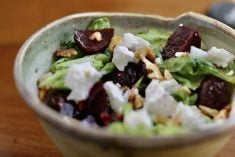Have you got that springtime feeling? People are digging out their Capri pants, golf shorts and t-shirts.
New season, new looks, why not some new recipes?
This recipe was featured in Most Loved Appetizers from Company’s Coming. Available since December 2003, the book brings more than two decades of Jean Pare’s most popular appetizer recipes. With this book in the pantry, you will never be caught without something to make for your guests. I was also given this recipe by a neighbour, Cairn Guran, of Rosetown, Sask., who is wonderful at sharing treats with our family.
Read Also

Communication key to bridging generation gap
Each generation is shaped by the predominant forces at play during their formative years. Acknowledging these influences can improve communication among the generations.
Mushroom rolls
1/4 cup butter or margarine 50 mL
1/2 pound fresh mushrooms, 250 g
chopped, or
1 can (10 oz.) mushrooms, 284 mL
chopped fine
1/2 cup chopped onion 125 mL
8 oz cream cheese, 250 g
softened and cut
1/2 teaspoon Worcestershire 2 mL
sauce
1/2 teaspoon salt 2 mL
1/8 teaspoon each pepper 0.5 mL
and garlic powder
1 loaf of sandwich bread,
sliced, crusts removed
Melt butter or margarine, add mushrooms and onions. Cook for five to 10 minutes until onion is softened. Add the next five ingredients, and stir until cream cheese is melted. Cool.
Roll bread slices with a rolling pin. Divide and spread mushroom mixture on each slice. Roll up and brush with the second amount of margarine or butter. Cut each roll into three pieces. Arrange in a single layer on ungreased baking sheet. Bake in 400 F (200 C) oven for 10-15 minutes until toasted. Makes about 48 rolls.
Note: You can make ahead by freezing the rolls. When ready to serve, take the rolls out, cut into three pieces and bake.
Spicy rice casserole
So easy to make and so good to eat.
2 cups beef stock or 500 mL
canned beef broth
1 cup uncooked long grain 250 mL
converted rice (not minute rice)
1 tablespoon oil 15 mL
1/3 cup diced onion 75 mL
3-4 fresh mushrooms, diced
1/2 cup frozen peas 125 mL
1/4 teaspoon chili powder 1 mL
1/4 teaspoon seasoning salt 1 mL
Add ingredients to a greased casserole. Stir and bake at 350 F (180 C) for 45 minutes. Fluff with a fork and serve.
Calgary Stampede ribs
2 pounds pork ribs 1 kg
1/2 cup brown sugar 125 mL
1/2 cup vinegar 125 mL
1 can (10 oz.) tomato soup 284 mL
1 small onion, finely chopped
1 teaspoon chili powder 5 mL
1 teaspoon celery seed 5 mL
1 teaspoon salt 5 mL
1/8 teaspoon cayenne pepper 0.5 mL
Mix the sugar, vinegar, soup, onion, and spices. Put ribs in a roaster and pour sauce over top. Bake at 350 F (180 C) for 21/2 hours.
Raspberry mallow squares
This recipe was served to me at the tea room in Herschel, Sask. So delicious. It was originally from Company’s Coming Desserts by Pare. It is a dessert that will wow your family and friends.
Crust:
1 cup all-purpose flour 250 mL
1/2 cup butter or margarine 125 mL
2 tablespoons sugar 30 mL
Filling:
3 oz. raspberry flavoured 85 g
gelatin
1 cup boiling water 250 mL
15 oz. frozen raspberries, 425 g
partly thawed
32 large white marshmallows
1/2 cup milk 125 mL
1 cup whipping cream 250 mL
Crust: Mix flour, butter and sugar until crumbly. Press into ungreased nine x13 inch (22 x 33 cm) pan. Bake in 350 F (180 C) oven for 10 minutes, until golden brown.
Filling: Stir gelatin and water together until dissolved. Add raspberries and mix together. Chill until syrupy. Pour over crumbs and chill.
Melt marshmallows in milk in top of a double boiler. Cool.
Whip cream until stiff. Fold into cooled marshmallow mixture and spread over firm raspberries. Chill and serve.
Pistachio dessert
Again, originally from Pare, a dessert I recently had at a rink kitchen. It is a light and refreshing change from rich desserts.
1 cup all-purpose flour 250 mL
1/2 cup butter or margarine 125 mL
3/4 cup finely chopped pecans 175 mL
Filling:
8 oz. cream cheese, softened 250 g
1 cup icing sugar 250 mL
1 pkg. six-serving size of
pistachio instant pudding
2 cups milk 500 mL
1 cup whipping cream 250 mL
Put butter and flour into a mixing bowl. Mix until crumbly. Stir in pecans (reserving 1/4 cup/50 mL for the top). Press into an ungreased nine x13 inch (22 x 33 cm) pan. Bake at 350 F (180 C) oven for 15 minutes. Cool.
Thoroughly mix cheese and sugar together. Spread over the crust.
Beat pudding mix with milk. Pour over the cheese layer and chill for five minutes to firm.
Whip cream until stiff. Spread over pudding layer and sprinkle with reserved pecans.
Too much rice choice
Dear TEAM: My family loves rice. It is quick, easy and nutritious. My problem is when I go to the store, there are so many varieties and instant dishes. How do I know which rice to choose? – M.M., via internet.
Dear M.M.: I am also a lover of rice. I think that it was the first thing I learned to cook as a child. There are many types of rice. Here are some facts from Uncle Ben’s Rice:
- Brown rice – Kernels of rice from which only the hull has been removed. Brown rice may be eaten as is or milled into regular white rice. Cooked brown rice has a slightly chewy texture and a nutlike flavour. The light brown colour is caused by the presence of bran layers that are rich in minerals and vitamins, especially the B-complex group. Brown rice provides slightly more fibre, vitamin E, phosphorus and calcium than white rice.
- Regular milled white rice – Rice that has the hull and bran layers removed. It is sometimes called milled rice, milled white rice, polished rice or polished white rice. The hulls, bran layers and germ have been removed.
- Converted brand rice – Rice that has been steamed and pressurized in a process that dissolves the vitamins and nutrients in the bran layer and deposits most of them in the white rice kernel before the bran is removed and the kernel polished. The resulting rice is more nutritious and even-textured than regular white rice. Because the process hardens the surface starch, converted brand rice (also called parboiled) produces non-sticky, separate grains that hold well.
- Instant rice – Cooked or instant rice has been cooked and then dehydrated to substantially reduce final preparation time.
- Aromatic rice – Brown or white rice with a natural aroma and flavours. Examples are jasmine and basmati rices.
- Sweet rice – An opaque white grain. Cooked grains are sticky and sweet rice is used to make sushi.
- Wild rice – Wild rice is not really rice at all, but a native North American grain with a similar appearance. It’s the seed from a water-grass plant, zizania aquatica. Until recently it grew only in the shallow lake waters of Minnesota and Canada, and was harvested by boat. In recent years commercial cultivation has substantially reduced the cost of this gourmet grain.
- Long grain rice – Long, slender kernel, four times longer than it is wide. Cooked grains are separate, light and fluffy.
- Medium grain rice – The kernel is two to three times longer than it is wide. Cooked grains are moist, tender and slightly clingy.
- Short grain rice – The kernel is almost round. Cooked grains cling together.
Long grain rice requires more water for preparation than medium, and medium requires more than short.
Starch composition is also different and generally longer grain rice is light and airy while shorter grain rice is creamy or sticky in texture after cooking.
Hence, long grain rice is preferred for boiling or steamed rice and rice salads, while the characteristics of medium and short grain rice are perfect for Italian risotto and rice puddings.
Curdled potatoes
Dear TEAM: I have a question about why my scalloped potatoes curdle. The recipe says that it will not curdle but it did. I followed the recipe to the letter except for the fact that my pan was perhaps a little larger than the two quarts that is called for. I know this because I had to add extra half and half cream to cover the potatoes. Is this where it went wrong? The cream was cold from the fridge. I used a stoneware pan, if that could have made any difference. – M. M., internet.
Dear M.M.: If you consistently have problems with whatever recipe you use for scalloped potatoes, it could be that your oven temperature setting is hotter than what it indicates. If you were using a larger pan, the mixture would have been spread in a thinner layer, which would have caused it to cook faster and get too hot. Also, a stoneware pan holds the heat and again could have gotten hot enough to curdle the mixture.
I would suggest that you try cooking them the next time in a cooler oven, such as 325 F (160 C), using the same pan and see if this helps. When the potatoes are just cooked, remove them from the oven because the stoneware pan will hold the heat and continue to cook even after being removed from the oven.
Also, if there is any acid added to the recipe such as lemon juice or vinegar, this will cause the milk to curdle. But it sounds like a heat problem.
Jodie Mirosovsky is a home economist from Rosetown, Sask., and one of four columnists comprising Team Resources. Send correspondence in care of this newspaper, Box 2500, Saskatoon, Sask., S7K 2C4 or contact them at team@producer.com.














